Analysis of Information System vs Management Information System
VerifiedAdded on 2022/12/22
|7
|1374
|67
Homework Assignment
AI Summary
This assignment provides an in-depth comparison between Information Systems (IS) and Management Information Systems (MIS), highlighting their distinct roles within an organization's IT infrastructure. It discusses how MIS, as a subset of IS, supports operational managers in making strategic decisions, often leveraging external data sources. The assignment further explores competitive advantages gained through advanced information systems, the impact of cross-functional enterprise architecture, and the significance of data warehousing. It also addresses the challenges and values associated with big data, emphasizing its role in generating timely insights and maintaining customer and business relationships through the integration of systems like CRM, ERP, and SCM. The document concludes by summarizing the implementation of IS and MIS to facilitate the supportive infrastructure of information technology of an organization, and how data warehousing and big data technologies can contribute to improved decision-making.
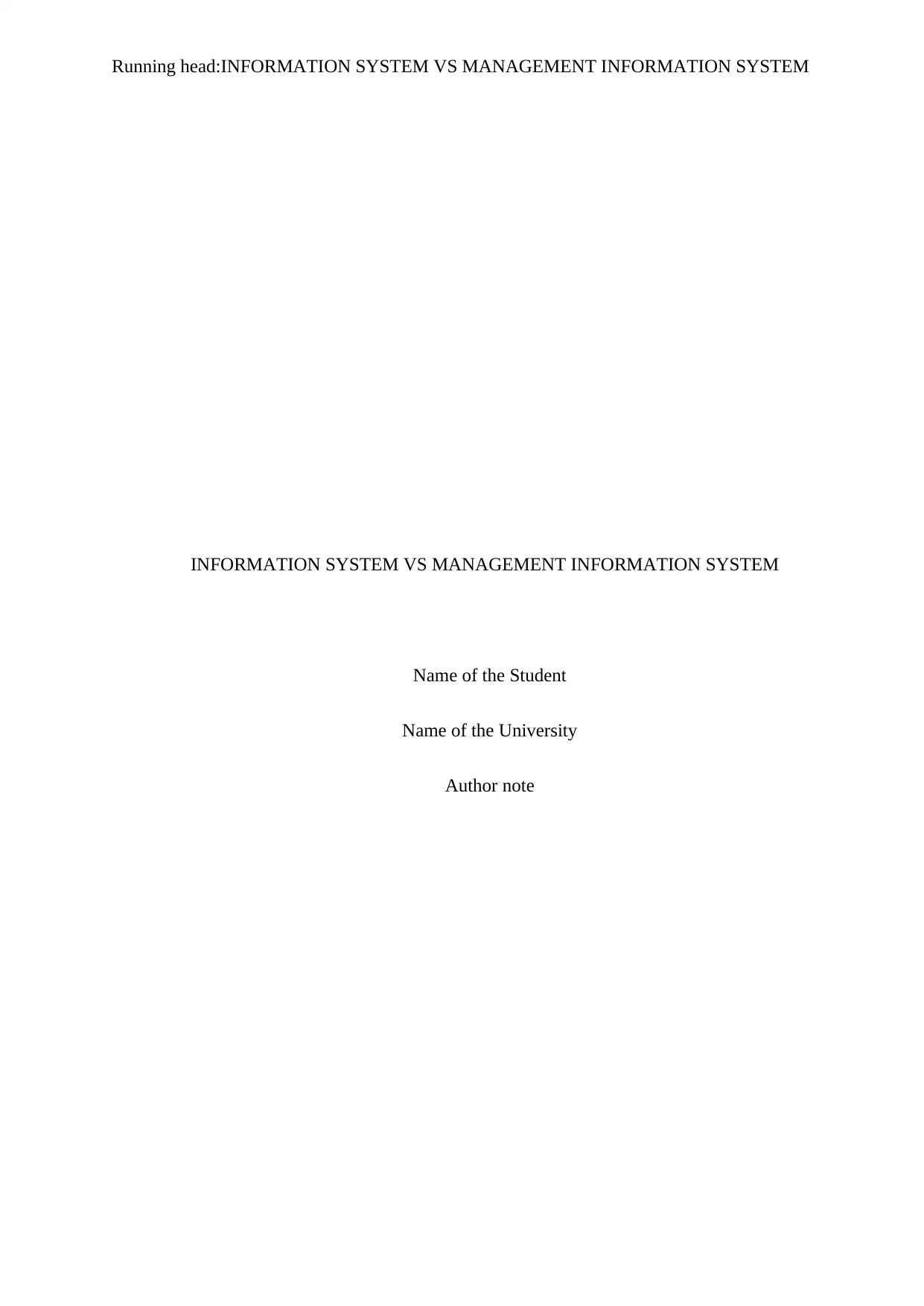
Running head:INFORMATION SYSTEM VS MANAGEMENT INFORMATION SYSTEM
INFORMATION SYSTEM VS MANAGEMENT INFORMATION SYSTEM
Name of the Student
Name of the University
Author note
INFORMATION SYSTEM VS MANAGEMENT INFORMATION SYSTEM
Name of the Student
Name of the University
Author note
Paraphrase This Document
Need a fresh take? Get an instant paraphrase of this document with our AI Paraphraser
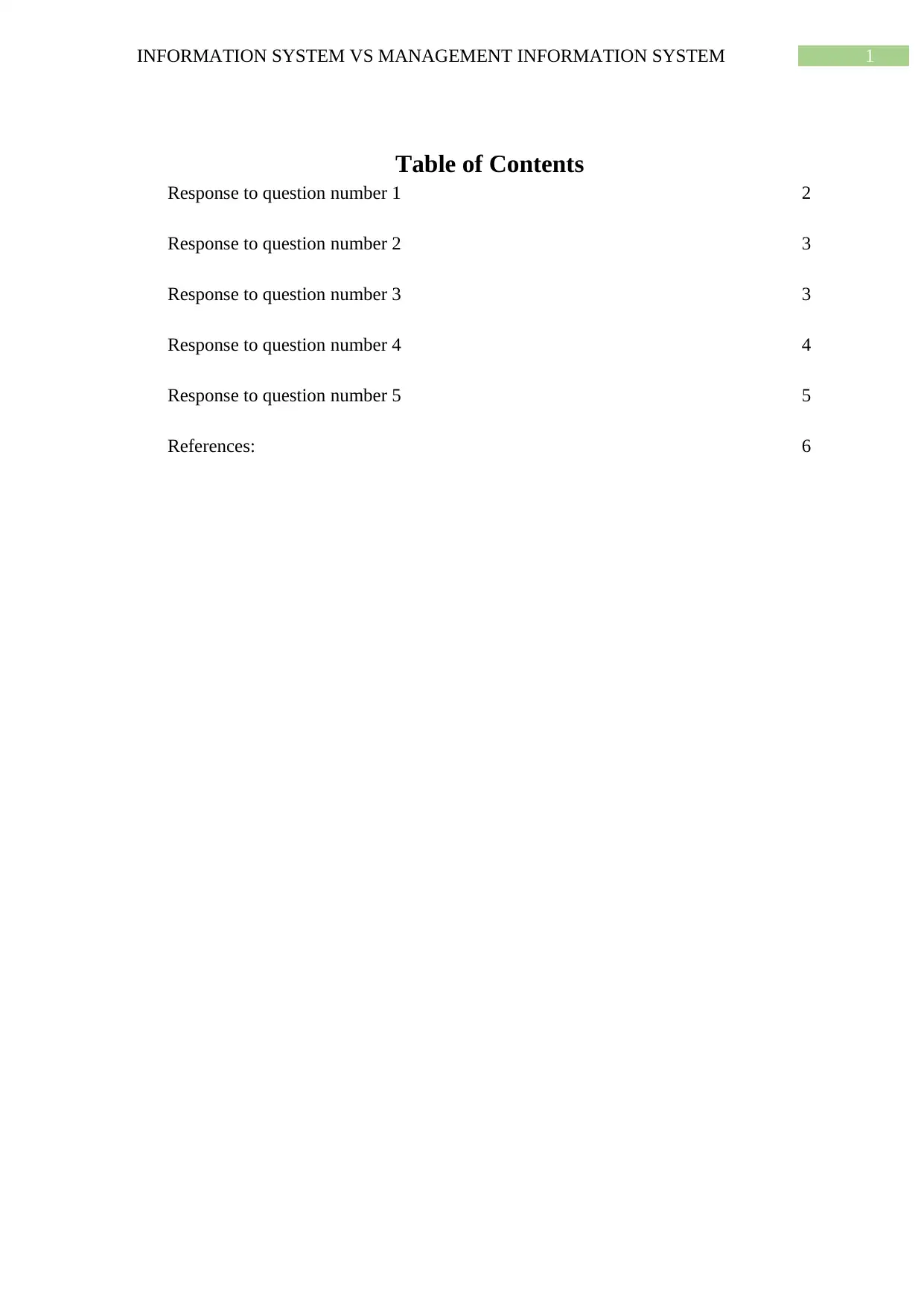
1INFORMATION SYSTEM VS MANAGEMENT INFORMATION SYSTEM
Table of Contents
Response to question number 1 2
Response to question number 2 3
Response to question number 3 3
Response to question number 4 4
Response to question number 5 5
References: 6
Table of Contents
Response to question number 1 2
Response to question number 2 3
Response to question number 3 3
Response to question number 4 4
Response to question number 5 5
References: 6
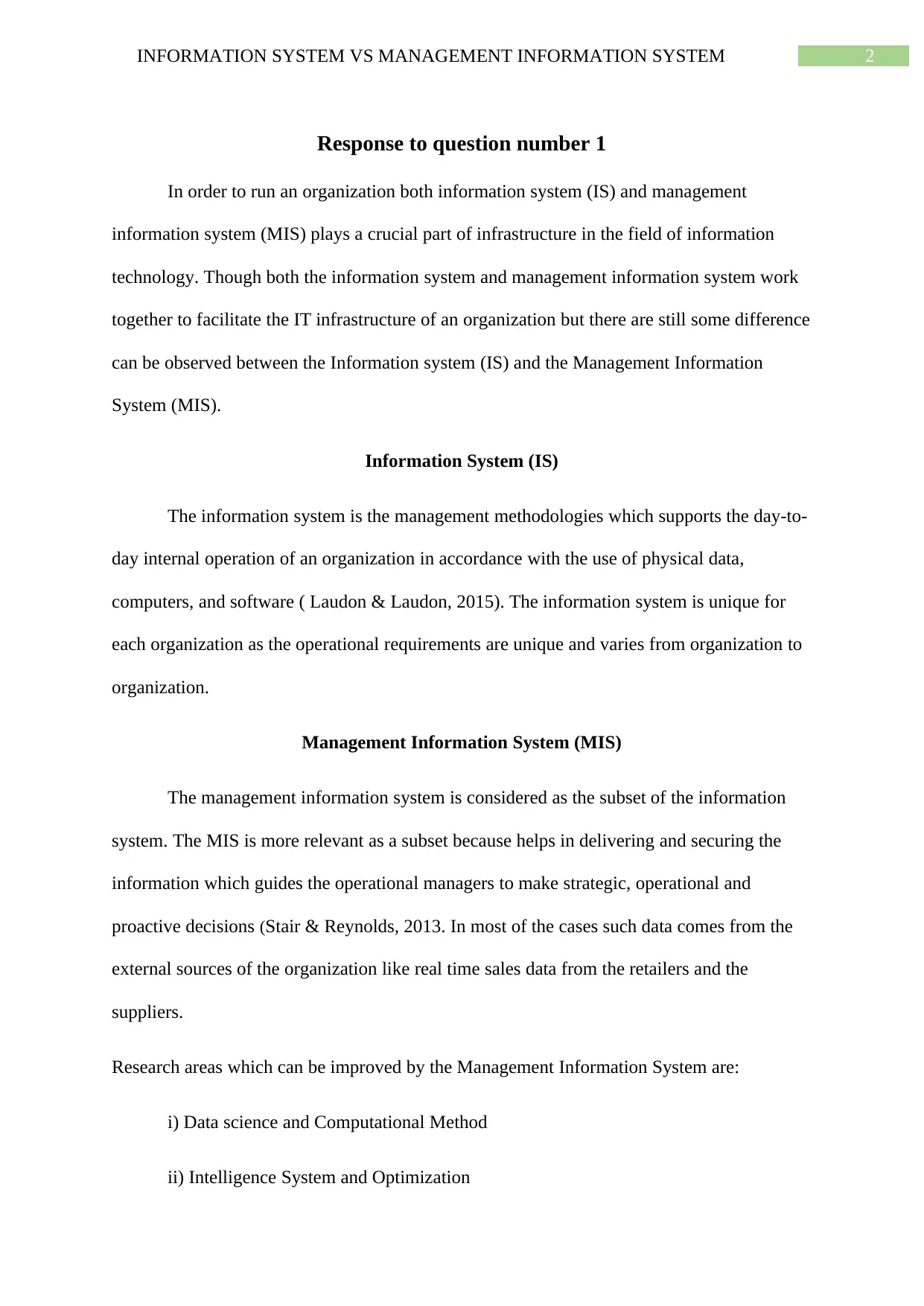
2INFORMATION SYSTEM VS MANAGEMENT INFORMATION SYSTEM
Response to question number 1
In order to run an organization both information system (IS) and management
information system (MIS) plays a crucial part of infrastructure in the field of information
technology. Though both the information system and management information system work
together to facilitate the IT infrastructure of an organization but there are still some difference
can be observed between the Information system (IS) and the Management Information
System (MIS).
Information System (IS)
The information system is the management methodologies which supports the day-to-
day internal operation of an organization in accordance with the use of physical data,
computers, and software ( Laudon & Laudon, 2015). The information system is unique for
each organization as the operational requirements are unique and varies from organization to
organization.
Management Information System (MIS)
The management information system is considered as the subset of the information
system. The MIS is more relevant as a subset because helps in delivering and securing the
information which guides the operational managers to make strategic, operational and
proactive decisions (Stair & Reynolds, 2013. In most of the cases such data comes from the
external sources of the organization like real time sales data from the retailers and the
suppliers.
Research areas which can be improved by the Management Information System are:
i) Data science and Computational Method
ii) Intelligence System and Optimization
Response to question number 1
In order to run an organization both information system (IS) and management
information system (MIS) plays a crucial part of infrastructure in the field of information
technology. Though both the information system and management information system work
together to facilitate the IT infrastructure of an organization but there are still some difference
can be observed between the Information system (IS) and the Management Information
System (MIS).
Information System (IS)
The information system is the management methodologies which supports the day-to-
day internal operation of an organization in accordance with the use of physical data,
computers, and software ( Laudon & Laudon, 2015). The information system is unique for
each organization as the operational requirements are unique and varies from organization to
organization.
Management Information System (MIS)
The management information system is considered as the subset of the information
system. The MIS is more relevant as a subset because helps in delivering and securing the
information which guides the operational managers to make strategic, operational and
proactive decisions (Stair & Reynolds, 2013. In most of the cases such data comes from the
external sources of the organization like real time sales data from the retailers and the
suppliers.
Research areas which can be improved by the Management Information System are:
i) Data science and Computational Method
ii) Intelligence System and Optimization
⊘ This is a preview!⊘
Do you want full access?
Subscribe today to unlock all pages.

Trusted by 1+ million students worldwide

3INFORMATION SYSTEM VS MANAGEMENT INFORMATION SYSTEM
iii) Cyber-security
The example of these system includes group discussion support system, logistics
system, computer supported cooperative work and financial planning system.
Response to question number 2
The areas or the organizational firms which have the Competitive advantage over the
other organizations or the firms have the privilege to access to the different and special
resources that are not available to others. The organizations that have the competitive
advantage over the other organizations due to the advancement of the Information System are
able to use and utilize their resources in a more efficient manner. The organization that have
access to the advanced information systems and have achieved the competitive advantage
over other organizations have the access to the resources in a more efficient manner which
results in a high growth of the revenue and collects the maximum amount of the profit and
the growth based on the productivity where in the long run the organization receives higher
rate of stock market than that of the competitors (Hughes, Le Bon & Rapp, 2013).
The technologies can affect the value added activities for their own management and
allows the organization to achieve more competitive advantage by using the required changes
in the scope of the competitive manner. The five competitive forces are the Traditional
competitors, new market entrants, Substitute products and services, customers and suppliers.
Response to question number 3
The cross functional enterprise architecture is very important for an organization
because it ensures the organization to share information across the business functionality.
The cross functional enterprise architecture is viewed as a strategic way to improve
efficiency and effectiveness of the business process and helps to share the information
iii) Cyber-security
The example of these system includes group discussion support system, logistics
system, computer supported cooperative work and financial planning system.
Response to question number 2
The areas or the organizational firms which have the Competitive advantage over the
other organizations or the firms have the privilege to access to the different and special
resources that are not available to others. The organizations that have the competitive
advantage over the other organizations due to the advancement of the Information System are
able to use and utilize their resources in a more efficient manner. The organization that have
access to the advanced information systems and have achieved the competitive advantage
over other organizations have the access to the resources in a more efficient manner which
results in a high growth of the revenue and collects the maximum amount of the profit and
the growth based on the productivity where in the long run the organization receives higher
rate of stock market than that of the competitors (Hughes, Le Bon & Rapp, 2013).
The technologies can affect the value added activities for their own management and
allows the organization to achieve more competitive advantage by using the required changes
in the scope of the competitive manner. The five competitive forces are the Traditional
competitors, new market entrants, Substitute products and services, customers and suppliers.
Response to question number 3
The cross functional enterprise architecture is very important for an organization
because it ensures the organization to share information across the business functionality.
The cross functional enterprise architecture is viewed as a strategic way to improve
efficiency and effectiveness of the business process and helps to share the information
Paraphrase This Document
Need a fresh take? Get an instant paraphrase of this document with our AI Paraphraser
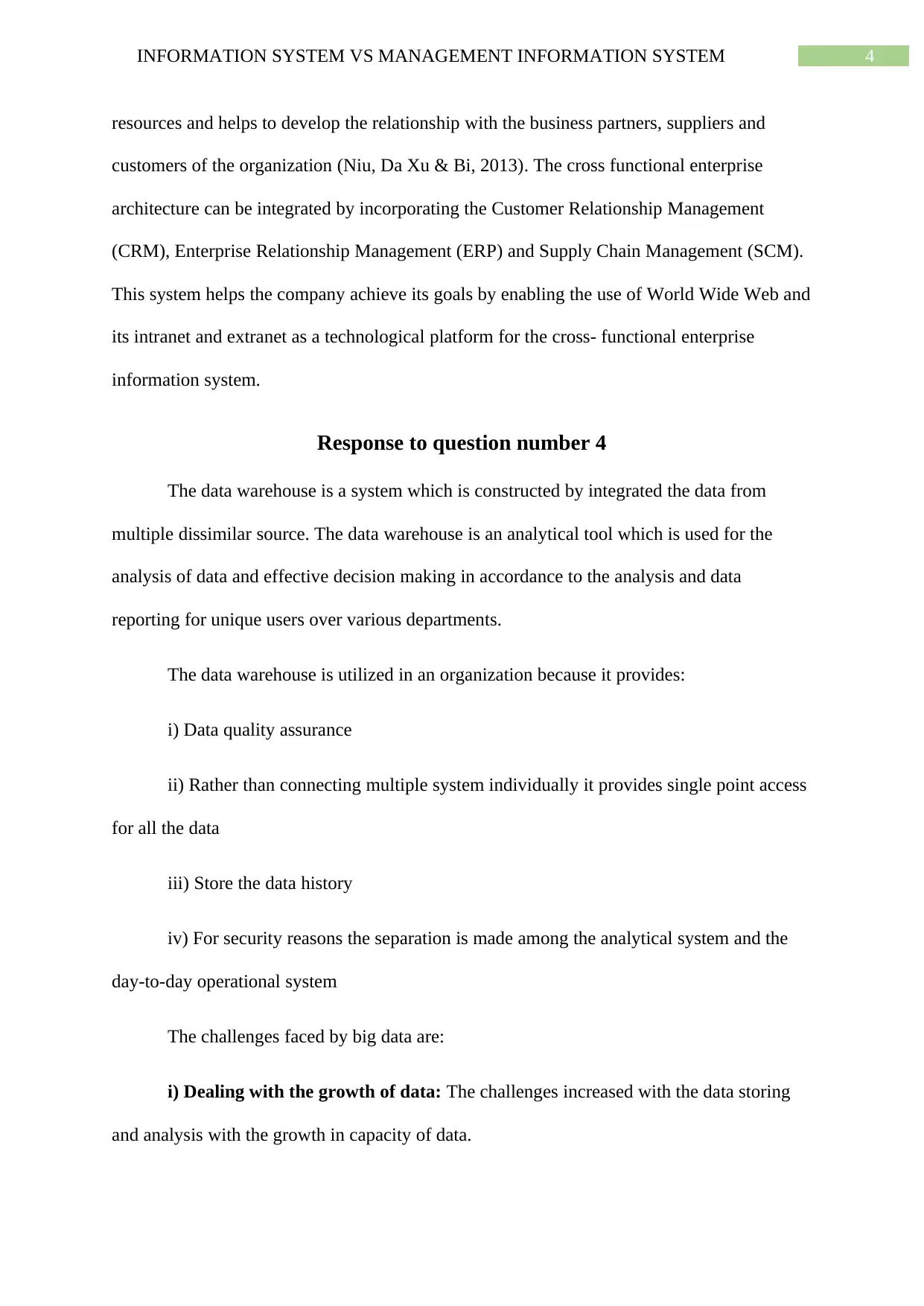
4INFORMATION SYSTEM VS MANAGEMENT INFORMATION SYSTEM
resources and helps to develop the relationship with the business partners, suppliers and
customers of the organization (Niu, Da Xu & Bi, 2013). The cross functional enterprise
architecture can be integrated by incorporating the Customer Relationship Management
(CRM), Enterprise Relationship Management (ERP) and Supply Chain Management (SCM).
This system helps the company achieve its goals by enabling the use of World Wide Web and
its intranet and extranet as a technological platform for the cross- functional enterprise
information system.
Response to question number 4
The data warehouse is a system which is constructed by integrated the data from
multiple dissimilar source. The data warehouse is an analytical tool which is used for the
analysis of data and effective decision making in accordance to the analysis and data
reporting for unique users over various departments.
The data warehouse is utilized in an organization because it provides:
i) Data quality assurance
ii) Rather than connecting multiple system individually it provides single point access
for all the data
iii) Store the data history
iv) For security reasons the separation is made among the analytical system and the
day-to-day operational system
The challenges faced by big data are:
i) Dealing with the growth of data: The challenges increased with the data storing
and analysis with the growth in capacity of data.
resources and helps to develop the relationship with the business partners, suppliers and
customers of the organization (Niu, Da Xu & Bi, 2013). The cross functional enterprise
architecture can be integrated by incorporating the Customer Relationship Management
(CRM), Enterprise Relationship Management (ERP) and Supply Chain Management (SCM).
This system helps the company achieve its goals by enabling the use of World Wide Web and
its intranet and extranet as a technological platform for the cross- functional enterprise
information system.
Response to question number 4
The data warehouse is a system which is constructed by integrated the data from
multiple dissimilar source. The data warehouse is an analytical tool which is used for the
analysis of data and effective decision making in accordance to the analysis and data
reporting for unique users over various departments.
The data warehouse is utilized in an organization because it provides:
i) Data quality assurance
ii) Rather than connecting multiple system individually it provides single point access
for all the data
iii) Store the data history
iv) For security reasons the separation is made among the analytical system and the
day-to-day operational system
The challenges faced by big data are:
i) Dealing with the growth of data: The challenges increased with the data storing
and analysis with the growth in capacity of data.
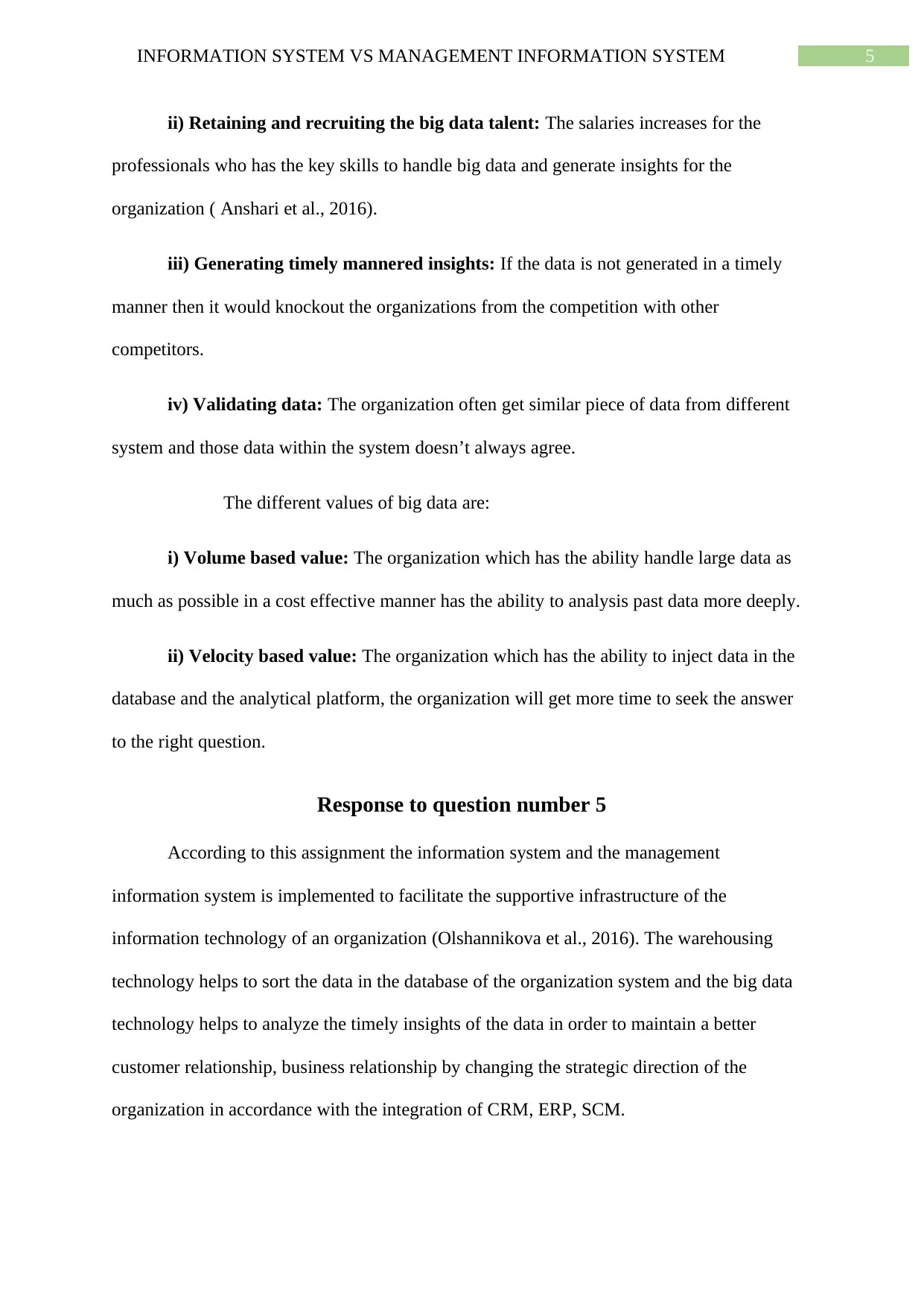
5INFORMATION SYSTEM VS MANAGEMENT INFORMATION SYSTEM
ii) Retaining and recruiting the big data talent: The salaries increases for the
professionals who has the key skills to handle big data and generate insights for the
organization ( Anshari et al., 2016).
iii) Generating timely mannered insights: If the data is not generated in a timely
manner then it would knockout the organizations from the competition with other
competitors.
iv) Validating data: The organization often get similar piece of data from different
system and those data within the system doesn’t always agree.
The different values of big data are:
i) Volume based value: The organization which has the ability handle large data as
much as possible in a cost effective manner has the ability to analysis past data more deeply.
ii) Velocity based value: The organization which has the ability to inject data in the
database and the analytical platform, the organization will get more time to seek the answer
to the right question.
Response to question number 5
According to this assignment the information system and the management
information system is implemented to facilitate the supportive infrastructure of the
information technology of an organization (Olshannikova et al., 2016). The warehousing
technology helps to sort the data in the database of the organization system and the big data
technology helps to analyze the timely insights of the data in order to maintain a better
customer relationship, business relationship by changing the strategic direction of the
organization in accordance with the integration of CRM, ERP, SCM.
ii) Retaining and recruiting the big data talent: The salaries increases for the
professionals who has the key skills to handle big data and generate insights for the
organization ( Anshari et al., 2016).
iii) Generating timely mannered insights: If the data is not generated in a timely
manner then it would knockout the organizations from the competition with other
competitors.
iv) Validating data: The organization often get similar piece of data from different
system and those data within the system doesn’t always agree.
The different values of big data are:
i) Volume based value: The organization which has the ability handle large data as
much as possible in a cost effective manner has the ability to analysis past data more deeply.
ii) Velocity based value: The organization which has the ability to inject data in the
database and the analytical platform, the organization will get more time to seek the answer
to the right question.
Response to question number 5
According to this assignment the information system and the management
information system is implemented to facilitate the supportive infrastructure of the
information technology of an organization (Olshannikova et al., 2016). The warehousing
technology helps to sort the data in the database of the organization system and the big data
technology helps to analyze the timely insights of the data in order to maintain a better
customer relationship, business relationship by changing the strategic direction of the
organization in accordance with the integration of CRM, ERP, SCM.
⊘ This is a preview!⊘
Do you want full access?
Subscribe today to unlock all pages.

Trusted by 1+ million students worldwide
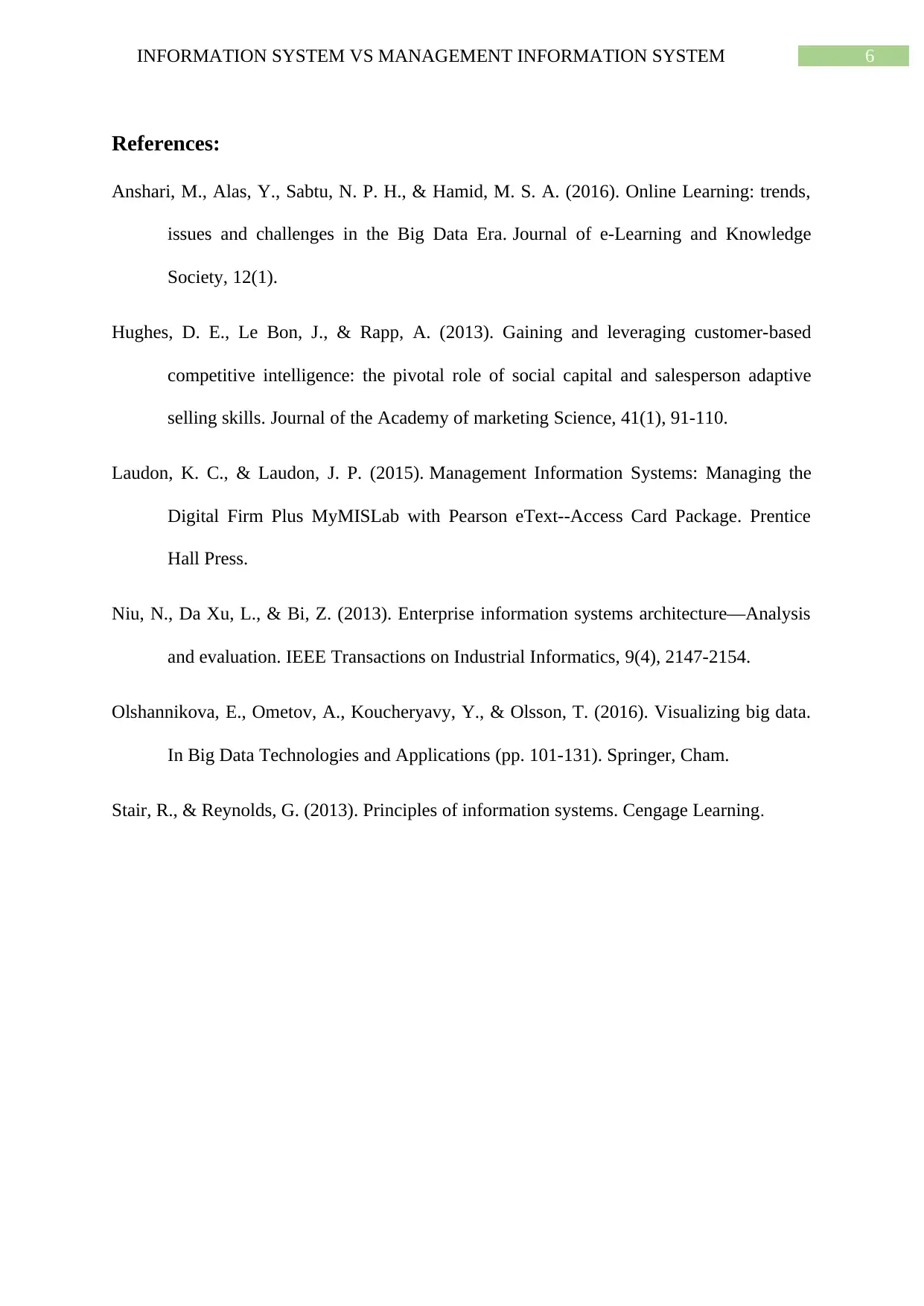
6INFORMATION SYSTEM VS MANAGEMENT INFORMATION SYSTEM
References:
Anshari, M., Alas, Y., Sabtu, N. P. H., & Hamid, M. S. A. (2016). Online Learning: trends,
issues and challenges in the Big Data Era. Journal of e-Learning and Knowledge
Society, 12(1).
Hughes, D. E., Le Bon, J., & Rapp, A. (2013). Gaining and leveraging customer-based
competitive intelligence: the pivotal role of social capital and salesperson adaptive
selling skills. Journal of the Academy of marketing Science, 41(1), 91-110.
Laudon, K. C., & Laudon, J. P. (2015). Management Information Systems: Managing the
Digital Firm Plus MyMISLab with Pearson eText--Access Card Package. Prentice
Hall Press.
Niu, N., Da Xu, L., & Bi, Z. (2013). Enterprise information systems architecture—Analysis
and evaluation. IEEE Transactions on Industrial Informatics, 9(4), 2147-2154.
Olshannikova, E., Ometov, A., Koucheryavy, Y., & Olsson, T. (2016). Visualizing big data.
In Big Data Technologies and Applications (pp. 101-131). Springer, Cham.
Stair, R., & Reynolds, G. (2013). Principles of information systems. Cengage Learning.
References:
Anshari, M., Alas, Y., Sabtu, N. P. H., & Hamid, M. S. A. (2016). Online Learning: trends,
issues and challenges in the Big Data Era. Journal of e-Learning and Knowledge
Society, 12(1).
Hughes, D. E., Le Bon, J., & Rapp, A. (2013). Gaining and leveraging customer-based
competitive intelligence: the pivotal role of social capital and salesperson adaptive
selling skills. Journal of the Academy of marketing Science, 41(1), 91-110.
Laudon, K. C., & Laudon, J. P. (2015). Management Information Systems: Managing the
Digital Firm Plus MyMISLab with Pearson eText--Access Card Package. Prentice
Hall Press.
Niu, N., Da Xu, L., & Bi, Z. (2013). Enterprise information systems architecture—Analysis
and evaluation. IEEE Transactions on Industrial Informatics, 9(4), 2147-2154.
Olshannikova, E., Ometov, A., Koucheryavy, Y., & Olsson, T. (2016). Visualizing big data.
In Big Data Technologies and Applications (pp. 101-131). Springer, Cham.
Stair, R., & Reynolds, G. (2013). Principles of information systems. Cengage Learning.
1 out of 7
Related Documents
Your All-in-One AI-Powered Toolkit for Academic Success.
+13062052269
info@desklib.com
Available 24*7 on WhatsApp / Email
![[object Object]](/_next/static/media/star-bottom.7253800d.svg)
Unlock your academic potential
Copyright © 2020–2025 A2Z Services. All Rights Reserved. Developed and managed by ZUCOL.


